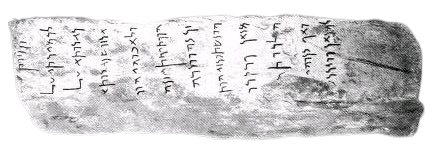Holy Spirit or Ghost in Syriac Aramaic is Rukha d'qudsha.
'Rukha' is spirit ,'d' is 'of' and 'qudsha' is holy.
Grammar gender of the Holy Spirit in Aramaic and other languages
The Holy Spirit in Syriac Aramaic is feminine and that is why images of the Holy Mother were used when speaking about the Spirit.The grammatical gender of the spirit varies according to the language.In Hebrew (רוּחַ, rūaḥ) it is both masculine and feminine while in Greek it is neutral (πνεῦμα, pneûma).
root of qudsha is qdsh-holiness
In Galilean Aramaic Holy Spirit is a little bit different-ruah qudsha
Now let's take a look at how it might be written in the Syriac Estrangelo and then the Aramaic block script (Hebrew).
The term "Ruha d'Qudsha" in Aramaic is composed of two parts: "Ruha" and "Qudsha."
1. Ruha: The word "Ruha" (ܪܘܚܐ) means "spirit" or "breath" in Aramaic. It is derived from the root word "Raha" (ܪܚܐ), which conveys the concept of wind, breath, or spirit. In the context of the Holy Spirit, "Ruha" refers to the divine, spiritual presence and power of God.
2. Qudsha: The term "Qudsha" (ܩܘܕܫܐ) means "holy" in Aramaic. It is derived from the root word "Qadash" (ܩܕܫ), which signifies the idea of sacredness, consecration, or holiness. When combined with "Ruha," "Qudsha" emphasizes the divine nature and sanctity of the Holy Spirit.
The phrase "Ruha d'Qudsha" is commonly used in Aramaic-speaking Christian traditions, particularly among Syriac Christians, who have historically used Aramaic as a liturgical and theological language. It reflects their understanding of the Holy Spirit as a distinct person within the Holy Trinity—Father, Son (Jesus Christ), and Holy Spirit.
It's worth mentioning that Aramaic was the language spoken by Jesus Christ during His earthly ministry, and it continues to be used in liturgical settings by various Christian communities in the Middle East, such as the Syriac Orthodox Church, Assyrian Church of the East, and Chaldean Catholic Church. These communities view Aramaic as an important part of their religious and cultural heritage.
Back to short Aramaic lessons





No, my associate, so if i may, the first "D" in d'Qudsha Means "OF", and RUKHA is NOT translated as Spirit In Aramaic, but rather as "BREATH", and QUDSHA Means "HOLY", So RUKHA D'QUDSHA Is translated as BREATH "Or" WIND OF HOLINESS.
ReplyDeletethe word "Spirit" comes from the latin word Spiritus (Aramaic is much older than latin), and although it is okay to say HOLY SPIRIT or SPIRIT (Either One Is Acceptable) in reference to GOD, since Aramaic reads from Right to Left, In Aramaic, RUKHA D'QUDSHA Is More Accurately Rendered as HOLY BREATH, BREATH OF HOLINESS, or It can also be translated as THE BREATH OF THE HOLY [ONE], as in --
ergo, THE BREATH OR WIND OF THE HOLY ONE.
ALAHA Means ABOVE THE FLAME,
Shlama D'Ishoa Baŕai'ah Baŕnasha Baŕ D'Alaha w Gushma Miltha D'Alaha/The Peace Of The Life-Giver And The Creator (Jesus), The Son Of Man, The Son Of Him Who Rises Above The Flame, And The Bodily Manifestation Of God 😘
Hope this was helpful, be good..
Amen and Amen
DeleteIshoa wasn't Alaha or creator not Aba. Ya need to go back to the roots. Hope you don't worship Ishoa. If you do you are an idolater.
ReplyDeleteHe was and is, read the book of John.
DeleteIshoa/EE-sho (Jesus) said he that has SEEN ME has SEEN THE FATHER.. period.
DeleteBefore there was any beginning the Mimra יהוה had been and the Mimra יהוה had been face to face at home with יהוה and the Mimra was יהוה (Targumic paraphrase IAHkhanan 1 :1 )
ReplyDeletePrivate communication:
DeleteI request permission to quote from this article. Please send me the form by E-mail.
I'll give all my information in my response.